Let’s evaluate 3D printing vs. traditional foam in custom seating
Get the insights from the State of Tennessee West Region Seating and Positioning Clinic on pressure mapping, comfort, and skin protection.
Real magic happens when you combine skills, knowledge, and innovative technology. At Create it REAL, we label ourselves 3D print experts and have developed the Programmable Foam® technology. With just over a year in the business of custom seating aids, we still have some ground to cover and experience to gain from the real seating and positioning experts. We are happy to be able to present this insight in the comparison between the traditional foam seat and our 3D-printed Programmable Foam® seat performed by the State of Tennessee West Region Seating and Positioning Clinic (TN).
Who is the State of Tennessee West Region Seating and Positioning Clinic?
TN has a high level of expertise in seating and positioning, which comes from years of hands-on experience and dedication to improving lives. The TN is a specialized center committed to serving individuals with complex needs, including cerebral palsy, spinal cord injuries, and muscular dystrophy. Their expert team of physical and occupational therapists provides personalized assessments and fabricates custom seating solutions designed to enhance mobility, posture, and comfort.
Combining on-site manufacturing with mobile services ensures greater accessibility for those who need it most. Their focus goes beyond just providing a seat—it’s about improving stability, protecting the skin, and enhancing the overall well-being of each individual they work with.
The clinical view
Andrew Hinkle, assistant director at West Tennessee Seating and Positioning Clinic, brings years of experience in evaluating and fabricating custom seating solutions for individuals with complex postural needs. With a deep understanding of clinical assessments and pressure mapping technology, Andrew specializes in finding the best fit for each client. He strongly advocates for innovation in seating technology, always seeking new ways to improve patient comfort, skin protection, and overall outcomes.
“Using an XSensor Pressure Mapping Tool, we saw improved peak and average pressures with the 3D-printed mold—without requiring modifications. It was astounding to see. This means less labor after fabrication and faster delivery to the client. From a clinical perspective, I was very impressed with the product and its potential for comfort, skin protection, and efficiency.”
This case compared 3D-printed custom-molded seating with traditional foam-based seating, evaluating pressure distribution, comfort, and overall effectiveness. Let’s have a look at the patient.
Patient case overview
The patient was referred to the TN for an updated solution. After years of using foam-based custom-molded seating, a 38-year-old client with cerebral palsy faced new challenges following a prolonged hospitalization. A new seating system became critical to accommodate postural complexities and protect fragile skin areas compromised during recovery.
Medical history
- Seizure disorder, shunt placement, bilateral hip osteotomy
- Severe scoliosis, pelvic asymmetries, and joint contractures
- Recent 6-month hospitalization due to aspiration pneumonia
- Developed multiple stage four pressure ulcers during hospitalization
Seating history
- Used foam-based custom molded seating for over 10 years
- Historically, he relied on tilt power functions for skin protection
Current need
- Requires a new seating system with a new power base
- Post-hospitalization considerations: Protection of healed areas over the sacrum and ischial tuberosities requires an enhanced approach
- Seating simulation results: Trunk-to-thigh (back-to-seat) angle of 110 degrees and seat depth of 18 inches
Challenges with traditional foam seating
Foam-based seating has long been the standard for custom-molded solutions, but it presents significant challenges, particularly for individuals with severe scoliosis and pelvic asymmetries. Manual shaping makes achieving an exact anatomical fit difficult, often requiring multiple adjustments to ensure proper support. Over time, the material compresses, reducing stability and increasing pressure points, which heightens the risk of pressure ulcers—especially for individuals who rely on their seating system for extended periods. The fabrication and adjustment process can also be lengthy, delaying access to a properly fitted solution.
Benefits of 3D-printed Programmable Foam® seating
The 3D-printed seating solution overcomes many of the limitations of traditional foam, offering superior support, pressure management, and durability. XSensor testing confirmed improved pressure distribution, with lower peak pressures achieved without modifications. The digitally designed fit accommodates scoliosis, asymmetries, and contractures, ensuring optimal anatomical support. By reducing pressure points, the 3D-printed seat enhances skin protection, helping to prevent ulcer recurrence. The streamlined production process minimizes post-processing, enabling faster delivery to the client. Unlike foam, the durable material retains its supportive properties over time, reducing the need for frequent replacements.
Pressure mapping results
Both seats were tested in upright, 30-degree tilt, and 45-degree tilt positions.
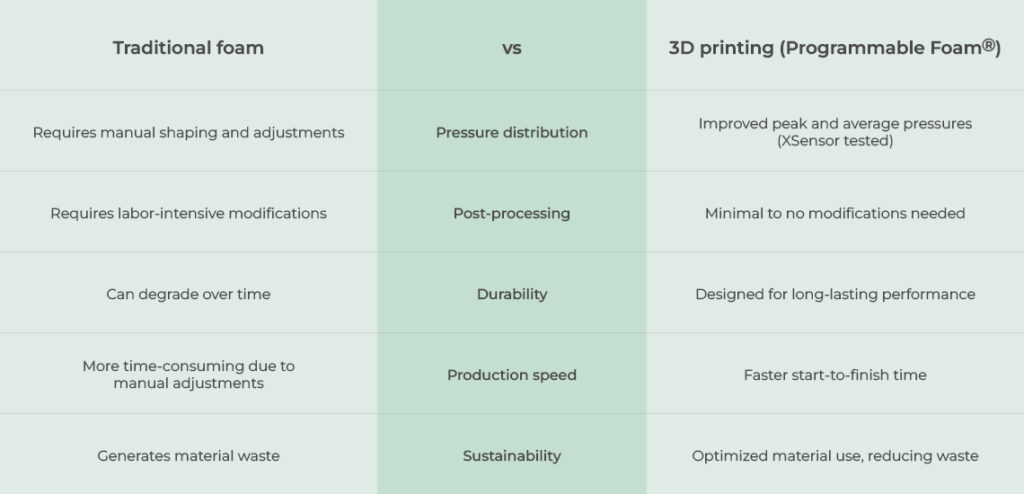

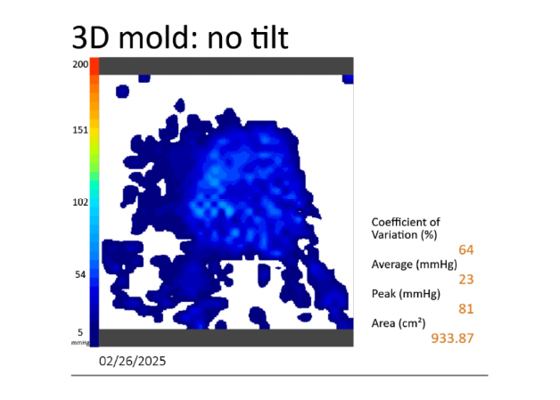
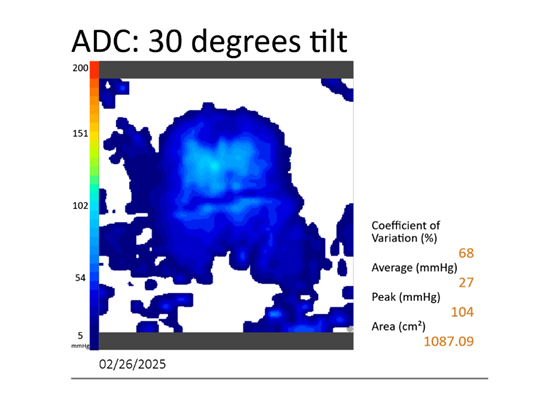
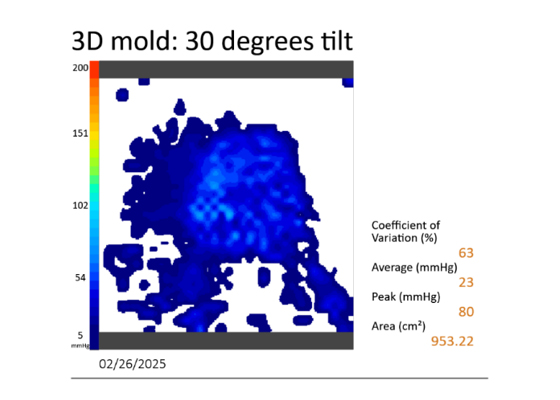

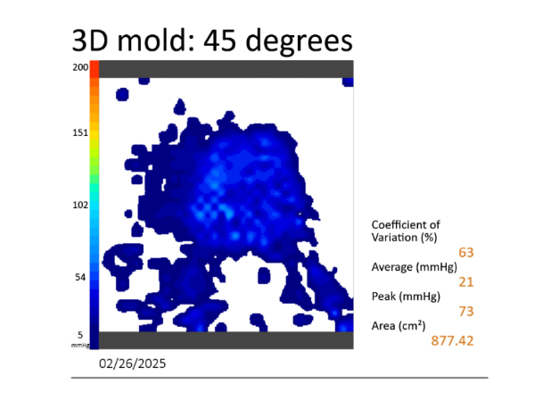
Conclusion
The results speak for themselves—the 3D-printed seating solution outperforms traditional foam in pressure distribution and overall support. Despite a smaller seating area, the average pressures were consistently lower across all positions. Most importantly, peak pressure points remained well below the critical 100 mmHg threshold, with a maximum of 81 mmHg in the upright position. This demonstrates the superior performance of 3D-printed seating in reducing pressure risks and enhancing long-term comfort.
Beyond pressure distribution, the 3D-printed seating solution offers production efficiency, durability, and sustainability advantages. The digital design eliminates the need for extensive manual adjustments, reducing production time. Additionally, the material maintains its integrity over time, minimizing the need for frequent replacements. Finally, the optimized material use significantly reduces waste compared to traditional foam fabrication methods.




